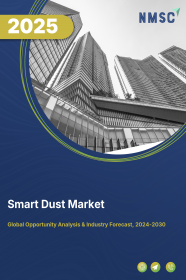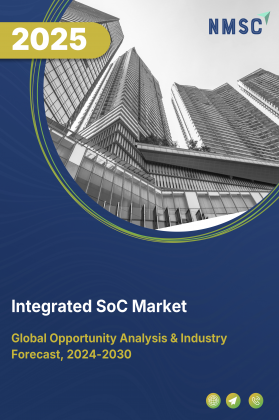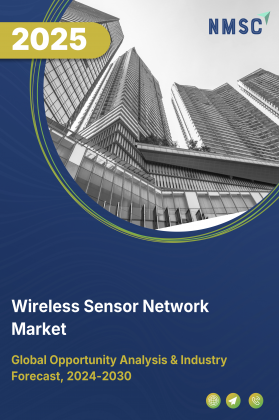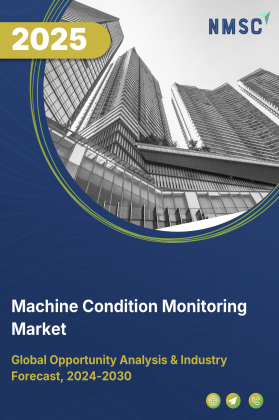
Smart Dust Market by Component (Sensors, Active Optical Transmission, Passive Optical Transmission, Optical Receiver, Analog I/O, Signal Processing, Control Circuitry, Power Source, and Others), by Manufacturing Process (3D Printing and Microfabrication), by Type (Biodegradable and Non-Biodegradable), and Others – Global Opportunity Analysis and Industry Forecast 2026-2030
Industry: Semiconductor & Electronics | Publish Date: 14-Feb-2025 | No of Pages: 262 | No. of Tables: 189 | No. of Figures: 159 | Format: PDF | Report Code : SE470
Market Definition
The global Smart Dust Market will value at USD 0.2 billion in 2025 and is predicted to reach USD 0.7 billion by 2030, at a CAGR of 20.4% from 2026 to 2030.
Modern cutting-edge technologies are focused on miniaturization along with automation. The history of computing has been defined by increased connectivity, the shrinking size of computing devices, and increased communication with the world. The rapidly growing popularity of smaller computing devices such as mobile phones and handheld computers along with the development of micro sensors and micro transistors have primarily accelerated the development of further nano computing devices. Thus, increased interaction with the environment and the emergence of small computing elements provides enriched opportunities to reshape interactions between computers, humans, and the environment.
These factors have led to the development of smart dust market growth , which is a collection of several microelectromechanical systems (MEMS) such as sensors and other devices that can sense light, temperature, magnetism, vibration, or chemicals, among others. Typical smart dust consists of nano-structured silicon sensors, which can autonomously orient, sense, assemble, and report on the environment it is present in.
This technology combines computing, sensing, autonomous power supply, and wireless communication capabilities, and utilizes them for several tasks such as monitoring environmental parameters. They are operated wirelessly on a computer network and deployed over a large area to carry out such activities with the help of radio frequency. Smart dust is designed to be light in weight and small in size, allowing it to float in an environment similar to dust particles. Smart dust properties will make it useful to monitor real-world phenomena without interfering with or harming the environment.
Smart dust can harvest the required energy with an inbuilt pre-quantum superposition processor and artificial intelligence that communicates wirelessly with the cloud. Smart dust is expected to become a significant tool in the fight against viruses and disease detection as it can monitor the environment in real-time. Contrary to conventional networks in an office setting, with further development smart dust is expected to replace wired routers in the near future and handle various hardware and software activities for distributed networks while utilizing less energy.
Integration of Smart Dust in the Medical Sector is Expected to Drive the Market in the Coming Years
Smart dust is increasingly being developed for the health sector globally, as it can help improve medical treatments through monitoring health by analyzing the process that takes place within the human body. For example, an appropriate fitting of a prosthetic limb – a medical process - could be significantly improved by utilizing smart dust. It can be scattered around the area where the prostheses are supposed to be attached, to monitor temperature, identify stress points, and check for appropriate implantation.
On the other hand, it can be used to assist in surgeries as the tiny particles can be transplanted into the human body to collect information to identify the right timing and approach while performing an operation.
In addition, smart dust can control the release of a drug or therapeutic compound using smart dust nanotechnology, which is gaining popularity in the medical industry. Smart Dust can enable a triggered release of medicine, which could be achieved from within or outside the body. Owing to the advancements of smart dust, there have been increased research efforts focused on the medical sector to understand how to release diagnostic molecules & drugs from liposomes with heat, and microbubbles using ultrasound.
Smart dust is used similarly to the manner in which embedded defibrillators and pacemakers are used to carry out health-monitoring processes; this is because implemented smart dust sensors can stimulate nerves and muscles, as well as monitor the activity of different organs. These are the factors that are expected to increase the adoption of smart dust in the medical industry, which will drive the growth of the market in the future.
Industrial Monitoring Capabilities of Smart Dust is Expected to Increase Its Global Adoption
Sensors are an integral part of industries as they are used to monitor appropriate workflow and increase the sustainability of industrial facilities. Smart dust provides a new prospect in the field of industrial monitoring. With the introduction of Industry 4.0, several industries are integrating technologies such as AI, data analytics, and IoT into their existing industrial facilities.
Smart dust in an industrial setting, typically relies on the IoT-based network of several small microelectromechanical systems (MEMS) that is used to detect and relay information about aspects such as temperature, humidity, and magnetic fields, among other parameters of industrial equipment to monitor their proper functioning. Smart dust is increasingly used to increase productivity as it can predict machinery failures & maintenance requirements, enable automated monitoring of inventory, ensure efficient quality control, and can generate real-time data regarding the environment of a plant. The above-mentioned factors are anticipated to increase the adoption of smart dust among multiple industries, which in turn fuels the growth of the market.
Privacy Concerns Associated with Smart Dust Hinders the Market Growth
The real-world implications of smart dust industry are interconnected with privacy issues associated with it. This is due to the fact that smart dust devices are sensors that can record anything that they are programmed to record in their vicinity. As they are very small it becomes impossible to detect and differentiate them from other natural particles with the human eye.
This has resulted in a negative privacy implication when smart dust falls into the wrong hands. Thus, governments will need to put in place legislative guidelines to permit the ethical use of the technology. This concern surrounding smart dust and its capabilities to breach human privacy in innumerable ways restrains the growth of the market.
The Controllability of Smart Dust is Expected to Pose Difficulties in its Widespread Adoption
Controllability is one of the major concerns among industries and organizations that deploy smart dust to attain their required tasks. As smart dust is deployed in large quantities, it makes it very difficult to retrieve or capture them as necessary. Given their small size, it would be difficult to detect them if someone is not made aware of their presence. Thus, the volume of smart dust that could be used to cause harm by a malicious individual, company, or any government would make it difficult for authorities to control. This is one of the major factors that hinder the growth and wide adaptability of smart dust.
The Introduction of Smart Dust in Space Research is Expected to Create Ample Opportunities in the Market
Smart dust is expected to play an important role in future space missions. Nanosensors dramatically improve high-performance materials or highly efficient propulsion systems. Smart dust sensors can be deployed in space or on the surface of a terrestrial planet where conventional detection systems would be impractical or difficult to place. International space exploration organizations are conducting various research and development activities on using nanoparticles such as smart dust to accumulate data during unmanned expeditions in outer space.
On the other hand, typical rocket engines rely on chemical propulsion and all current spacecraft use some form of chemical rockets that need to be launched. However, researchers and space organizations are developing electric propulsion (EP) systems as they can significantly reduce the propellant mass required in conventional chemical rockets, making way for the payload capacity to be increased along with a decrease in launch mass.
Few electric propulsion (EP) concepts propose the utilization of electrostatically charged and accelerated nanoparticles as propellants while using smart dust as sensor arrays. This allows millions of micron-sized nanoparticle thrusters to be fitted in one square centimeter, permitting the fabrication of highly scalable thruster arrays for future electric propulsion systems. The above-mentioned uses of smart dust are expected to create ample opportunities in the future.
North America Held the Largest Smart Dust Market Share, Backed by Notable R&D Activities in the Defence Sector
North America is the leading region globally in terms of the development of smart dust at present and is expected to continue its dominance during the forecast period 2022-2030. This is attributed to factors such as high military expenditure in countries such as US and Canada that enables the military to expand its R&D activities in advanced technologies such as Smart dust for numerous military applications.
For instance, as of March 2022, the proposed U.S. Department of Defense (DOD) budget for research and development for 2023 is $130.1 billion. In addition, the rapid expansion of industries such as agriculture, healthcare, and manufacturing is further fuelling the wide acceptance of smart dust in the region. Smart dust is currently being developed to monitor the environment and soil in the agriculture industry to forecast a suitable time of crop harvesting.
Also, the development of smart dust biosensors that can be injected into the human body for diagnostic purposes is creating new possibilities in the healthcare industry, which in turn could further fuel the smart dust market growth in future.
Europe is Expected to Display Steady Growth in the Smart Dust Industry
Rigorous research and development of smart dust in the region is creating new opportunities for this technology, which propels the growth of smart dust in Europe. This region is investing heavily in several smart dust projects and is supporting collaborations between research institutes, universities, and private entities.
For instance, the European Union contributed $0.4 million to a research project called WIROX. This research project was coordinated by the University of Brescia, Italy. WIROX (oxide nanostructures for wireless chemical sensing) was established to address the problem of incorporating electrical gas sensors into motes. Smart dust particles or motes comprise spatially distributed platforms and use autonomous sensors to monitor the physical or chemical environment.
Competitive Landscape
Various market players operating in the smart dust market include HP, Cisco Systems Inc, Analog Devices, Lightricity Ltd, IBM, CubeWorks, SINTEF, Sonardyne International Ltd, General Electric, and Hitachi.
Smart Dust Market Key Segments
By Component
-
Sensors
-
Active Optical Transmission
-
Passive Optical Transmission
-
Optical Receiver
-
Analog I/O
-
Signal Processing
-
Control Circuitry
-
Power Source
-
Others
By Manufacturing Process
-
3D Printing
-
Microfabrication
By Type
-
Biodegradable
-
Non-Biodegradable
By Application
-
Humidity Monitoring
-
Temperature Automation
-
Surveillance
-
Pressure & Stress Monitoring
-
Sound Monitoring
-
Others
By End-Use
-
Aerospace & Defense
-
Pharmaceutical & Lifesciences
-
Agriculture
-
Industrial
-
Government
-
Construction
-
Transportation & Logistics
-
Telecommunication
-
Others
By Geography
-
North America
-
U.S
-
Canada
-
Mexico
-
-
Europe
-
UK
-
Germany
-
France
-
Italy
-
Russia
-
Rest of Europe
-
-
Asia-Pacific
-
China
-
Japan
-
South Korea
-
Taiwan
-
Australia
-
Singapore
-
Rest of Asia-Pacific
-
-
RoW
-
Latin America
-
Middle East
-
Africa
-
Report Scope and Segmentation
|
Parameters |
Details |
|
Market Size in 2025 |
USD 0.2 Billion |
|
Revenue Forecast in 2030 |
USD 0.7 Billion |
|
Growth Rate |
CAGR of 20.4% from 2026 to 2030 |
|
Analysis Period |
2025–2030 |
|
Base Year Considered |
2025 |
|
Forecast Period |
2026–2030 |
|
Market Size Estimation |
Billion (USD) |
|
Growth Factors |
Integration of smart dust in the medical sector Industrial monitoring capabilities of smart dust |
|
Countries Covered |
19 |
|
Companies Profiled |
10 |
|
Customization Scope |
Free customization (equivalent up to 80 analysts working hours) after purchase. Addition or alteration to country, regional & segment scope. |
|
Pricing and Purchase Options |
Avail customized purchase options to meet your exact research needs. |
Key Players
-
HP
-
Cisco Systems Inc.
-
Analog Devices
-
Lightricity Ltd.
-
IBM Corporation
-
CubeWorks
-
SINTEF
-
Sonardyne International Ltd.
-
General Electric
-
Hitachi




















 Speak to Our Analyst
Speak to Our Analyst

























